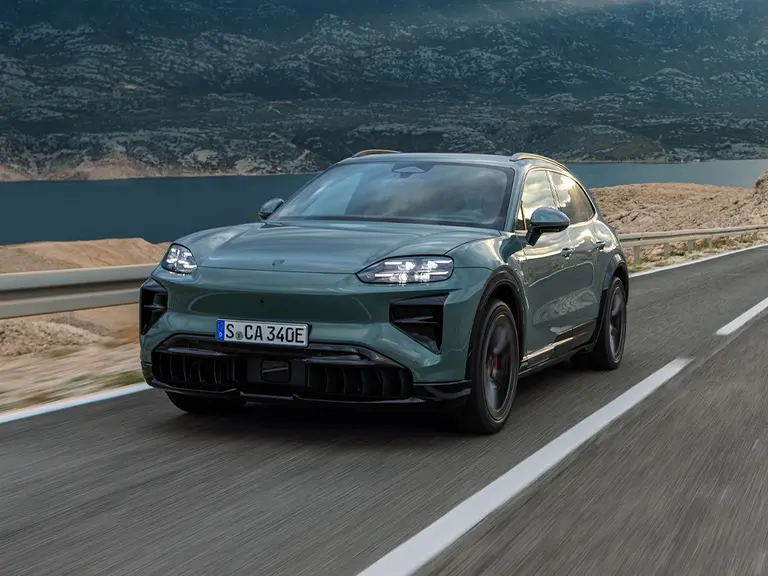
Published:
Readtime: 5 min
Every product is carefully selected by our editors and experts. If you buy from a link, we may earn a commission. Learn more. For more information on how we test products, click here.
Porsche isn’t messing around on its way to becoming the most technologically advanced electric vehicle manufacturer on the planet. The unveiling of their new Porsche Mission X concept has four distinct goals in mind; create the fastest road-legal car on the Nürburgring Nordschleife under test conditions, have a power-to-weight ratio of roughly one PS per kilogram, more downforce than the current 911 GT3 RS, and charge roughly twice as quickly as the Taycan Turbo S.
The good news is that, unlike a number of electric vehicle manufacturers, their track record shows that they’ll actually achieve their mission. Need we remind you of the Porsche 959, Carerra GT or 918 Spyder?
RELATED: 2023 Porsche GT4 RS Review: 24 Hours in a Road-Legal Race Car

Porsche Mission X Concept | Image: Supplied
While we were bullish on the fact that Porsche would unveil a new car on June 8th (just before Le Mans opening weekend), all fingers pointed towards the Porsche 911 ST. However, in true Porsche fashion, they pulled a full 360 and have revealed an all-electric Porsche Mission X Concept to the world.
Michael Mauer, Head of Style Porsche, says this supercar will be “an important compass for us to navigate the development of our series-production models.” So you don’t have to read too far into it to understand that a version of this concept will become the next Porsche supercar.
Speaking of which, Porsche has mimicked the dimensions of its last two supercars with the Mission X Concept. Measuring 4.5 metres long, 2.0 metres wide, and with a wheelbase of 2.73 metres, it has the dimensions of the Carrera GT and 918 Spyder. And to give it a certain rake for aerodynamics, the rear wheels are an inch larger than the front; 20-inch front, 21-inch rear. Stand next to it and you’ll be shocked how low the roof height is at just 1.2 metres tall – a full 10cm lower than a current generation 911.

Porsche Mission X Concept | Image: Supplied
Looking beyond the gorgeous design and form factor for a second and the details read like an engineering study… because it is. Most importantly for the world of electric vehicles, the battery is installed centrally behind the vehicle’s seats. Most modern EVs have their batteries installed in the floor which adds excess weight over the length of the vehicle. Mounting the battery in an ‘e-core layout’ centres the mass in the car and forces it to act like a mid-engined car.
The shopping list of features that jump off the page includes.
- A rear axle fitted with transparent aero blades, designed like turbines to cool the brakes.
- A lightweight glass dome with an exoskeleton made of carbon fibre over your head.
- Le Mans-style doors attached to the A-pillar and the roof that open forwards and upwards.
- Lights that adopt a four-point graphic from the 906 and 908 racing cars, blink like an eye.
Our favourite angle of the car has to be the rear three-quarter view with a Porsche script that’s reminiscent of the Taycan seemingly floating over the rear support structure. In true Porsche fashion, they’ve gone so far as to illuminate and pulsate the ‘E’ of the Porsche lettering while charging. Finally, the latest Porsche crest appears in brushed precious metal and gold colour combination that’s matched to a three-dimensional honeycomb structure. It works well with the new Rocket Metallic exterior colour.

Porsche Mission X Concept | Image: Supplied
Being a concept (for now), we’d expect few details on the interior to make their way to the production car. However, the brand has made special mention of the seats which are coloured differently to mark driver and passenger. Made from CFRP, the seats are fitted with six-point seatbelts integrated into the monocoque, while an open-top steering wheel also finds its way into the cabin. Fingers crossed the production car will get a round steering wheel for road use.
You’ll notice the clock on the passenger side of the vehicle, this is attached via a bayonet system embedded in the instrument panel. Here, the passenger can utilise a Porsche Design stopwatch module to display lap times in digital or analogue styles. We’d imagine the new passenger screen in the new Taycan and Cayenne would find their way to the production car.
While pricing, availability, and series production announcements have not been made, Porsche has stated its goal for the Mission X Concept. This is going to be the fastest road-legal vehicle on the Nürburgring Nordschleife. Following the lead of the 652 kW (887 PS) 918 Spyder that became the first road-approved vehicle to crack the seven-minute barrier on the 20.6-kilometre Nordschleife circuit with a time of 6:57 minutes. Prepare yourself.

Porsche Mission X Concept | Image: Supplied

Porsche Mission X Concept | Image: Supplied
You’ll also like:































Comments
We love hearing from you. or to leave a comment.